Now that smartphone specs are better than ever, and the competition for your next flagship is even more cut throat, one of the most important features mobile manufacturers emphasize is how well their handsets can snap a pic. Even Apple’s latest “shot on an iPhone 6” ad campaign touts the device’s camera quality with sweeping and dramatic user photos plastered on billboards (though its parodied campaign does not).
Related stories:
- Samsung Galaxy S6: Samsung’s new superphone wows us on day one
- Samsung Galaxy S6 Edge: Curved design makes this the S6 to crave
- HTC One M9: A gorgeous phone with a touch of déjà vu
- Apple iPhone 6: iPhone 6 sets the smartphone bar
To compare how well the cameras of the latest and most popular flagships perform, I took the Samsung Galaxy S6 (which has a 16-megapixel camera), the HTC One M9 (20MP) and the Apple iPhone 6 (8MP) around San Francisco. I captured everyday situations, both indoor and outdoor with varying lighting, for real-world testing that reflected how average phone users take photos daily.
Every photo in each set were taken within minutes (if not seconds) of one another, at the same location and distance from the focal object. However, due to different aspect ratios on the iPhone, it will appear as if I am closer or farther at times (though I was not). Except for two instances when High-Dynamic-Range (HDR) mode was turned on (below in “Sunny days in San Francisco” and “Tricky lighting at the Slanted Door”), all cameras were set on Auto. One photo (“Night time in the City”) was taken with the Galaxy S6 Edge , but don’t worry — it’s equipped with the same exact camera as the Galaxy S6.
Fully metal Samsung Galaxy S6 looks sharp (pictures)
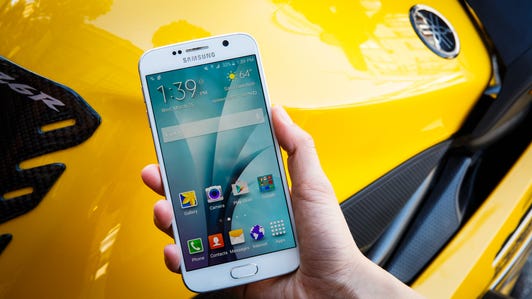





+25 more
After analyzing the photos, I found that all in all, both the Galaxy S6 and the iPhone 6’s cameras were far superior to the One M9 — proving that just because your phone has a high megapixel count, doesn’t mean it will take the best pictures. With outdoor environments, the M9 blew out and overexposed light sources more often. Dim, indoor environments are even worse; objects are noticeably more blotchy and grainier when compared to the other two. In addition, unlike the Galaxy S6 and the iPhone 6, both of which render HDR images almost instantaneously, the M9 takes a while to process HDR photos.
As for the iPhone, its biggest strength is with low-light environments. Though it won’t have the brightest exposure in the end per se, its photos are sharper and look more natural. It also reduces the amount of lens flare beaming from different light sources. In addition, its white balance captures the purest and cleanest white hues.


Now playing:
Watch this:
Camera comparison: The Galaxy S7 Edge vs. the iPhone…
2:41
Finally, compared to Apple’s handset and the M9, the Galaxy S6 takes livelier and punchier photos, especially when it comes to colorful objects like fruit and flowers that have red, green, and yellow hues. I found myself favoring several photos from the Galaxy S6 simply because they packed a lot more punch and vibrancy. (The downside, of course, is that if you’re a stickler for accuracy, you may prefer the iPhone. Though its pictures can look a tad more muted or washed out compared to the Galaxy S6, it is, at the end of the day, more true-to-life.)
All in all, the M9 proved a disappointment, while the Galaxy S6 and the iPhone 6 were pretty neck-and-neck. Personally, I’d give the Galaxy S6 the slight edge, since I’m partial to its saturated tones that come off bright without looking too unrealistic (a characteristic that plagued Galaxy cameras before).
To see for yourself, check out the photos below, and click on the magnifying glass icon to view these photos at their full resolution. Also, be sure to tell us what you think in the reader comments below.
1. A sunny day on the pier
Here, the M9’s picture is the brightest, and while that lightened up the grey sidewalk nicely, some areas of the photo were overexposed, especially in the right-hand corner where the sun was shining. I like the deeper blue sky that the iPhone 6 captured, but objects in the background, like the second dock behind the seagull, looks hazy and more muted compared to the ones from the Galaxy S6 and M9.
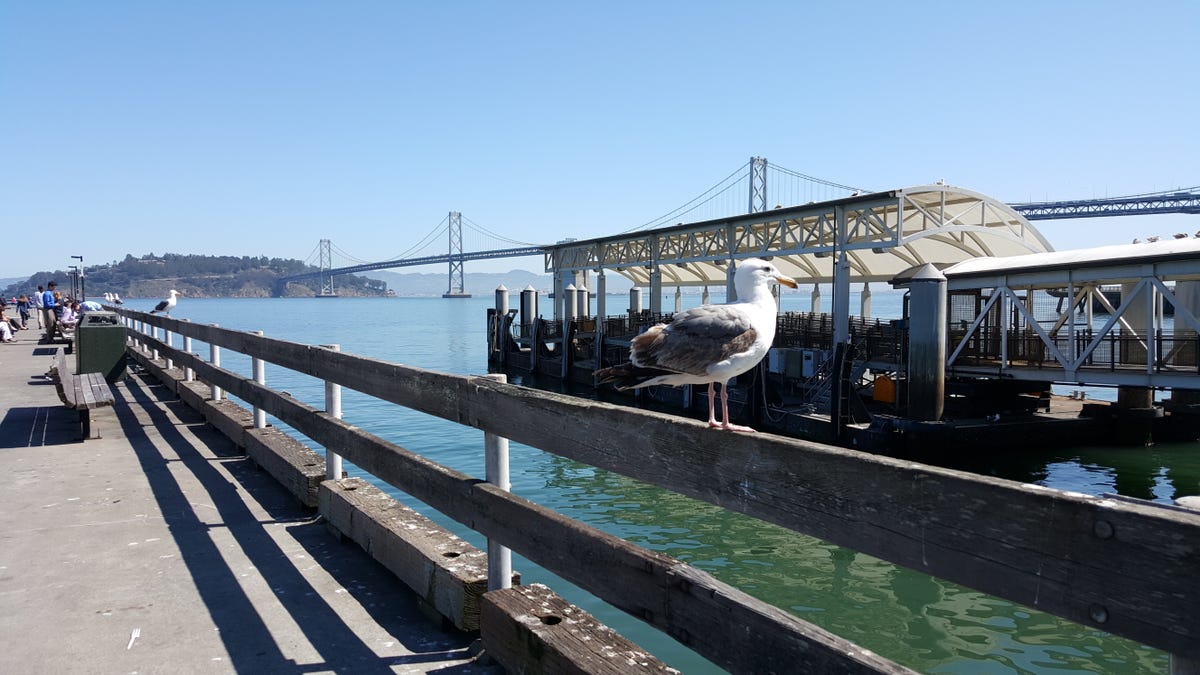
 Enlarge Image
Enlarge ImageLynn La/CNET

 Enlarge Image
Enlarge ImageLynn La/CNET
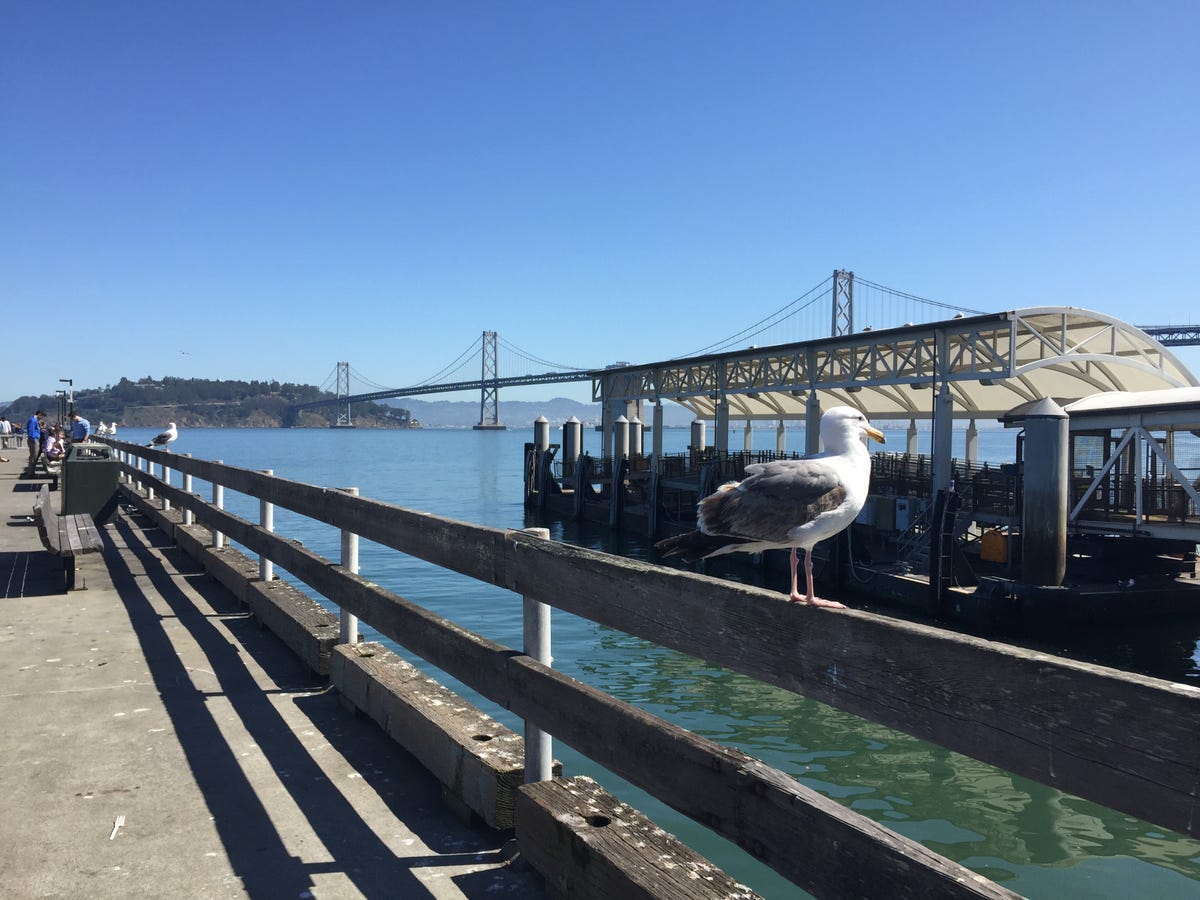
 Enlarge Image
Enlarge ImageLynn La/CNET
2. Eying the top shelf
In this well-light indoor photo, I’m partial to the darker blacks and red hues captured with the M9. The shadowing in the middle shelves also lend more depth to the image, in contrast to the iPhone’s, which looks hazy around that same area. At full resolution, however, the Galaxy S6 captured more details, particularly in the lettering in the bottles’ labels, and the details in the bricks.

 Enlarge Image
Enlarge ImageLynn La/CNET

 Enlarge Image
Enlarge ImageLynn La/CNET

 Enlarge Image
Enlarge ImageLynn La/CNET
3. Up close with a Stargazer Lily
In this set, I prefer the Galaxy S6’s picture above all three. Colors really pop, especially the fuchsias, greens, and yellows, without looking too overly-saturated and unrealistic. Even the creases in the leaf to the left have more texture. The M9 comes in at a close second, and the iPhone, while it had the most accurate-looking colors, appeared too bluish and cold to be favored.
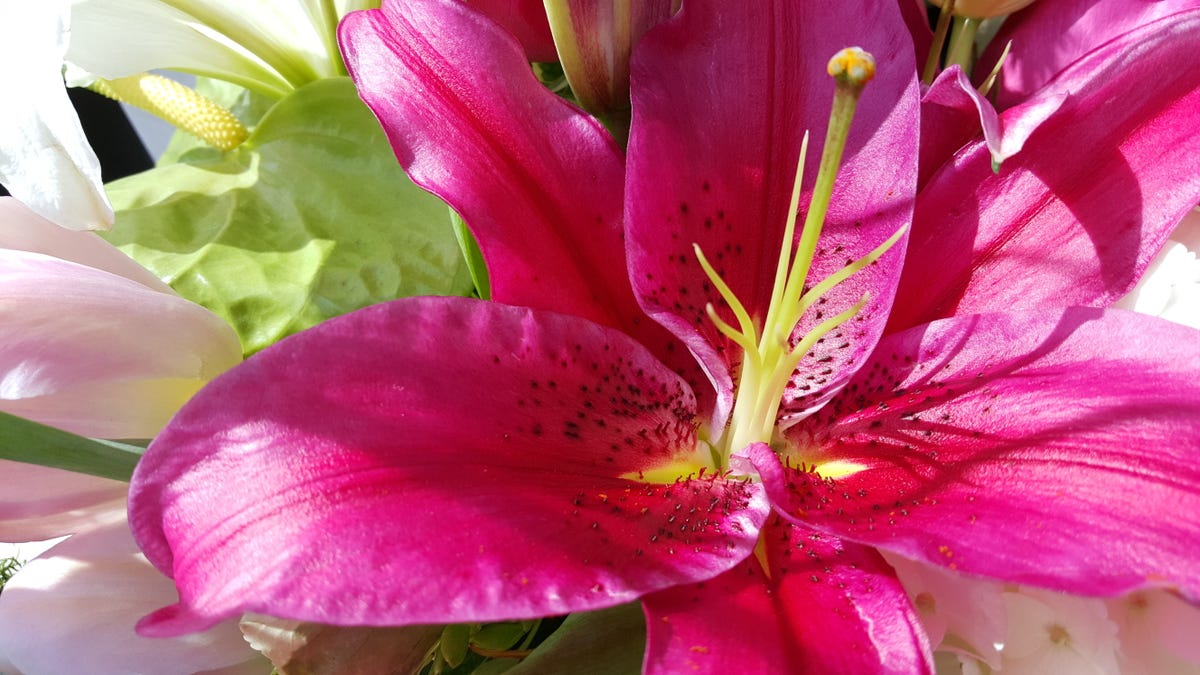
 Enlarge Image
Enlarge ImageLynn La/CNET

 Enlarge Image
Enlarge ImageLynn La/CNET

 Enlarge Image
Enlarge ImageLynn La/CNET
4. How do you like them apples?
Once again, I’d hand it to the Galaxy S6 on this one. The red and yellow hues are vibrant and have a lot more punch. In turn, the apples in the iPhone look washed out and the Golden Delicious’ in the middle appear particularly pale. The M9 is a happy medium between the two (though I still like how the Galaxy S6’s photo more) — the apples come off livelier than the iPhone’s, but if you’re not a fan of the Galaxy S6’s saturated tones, the M9 is more true-to-life.
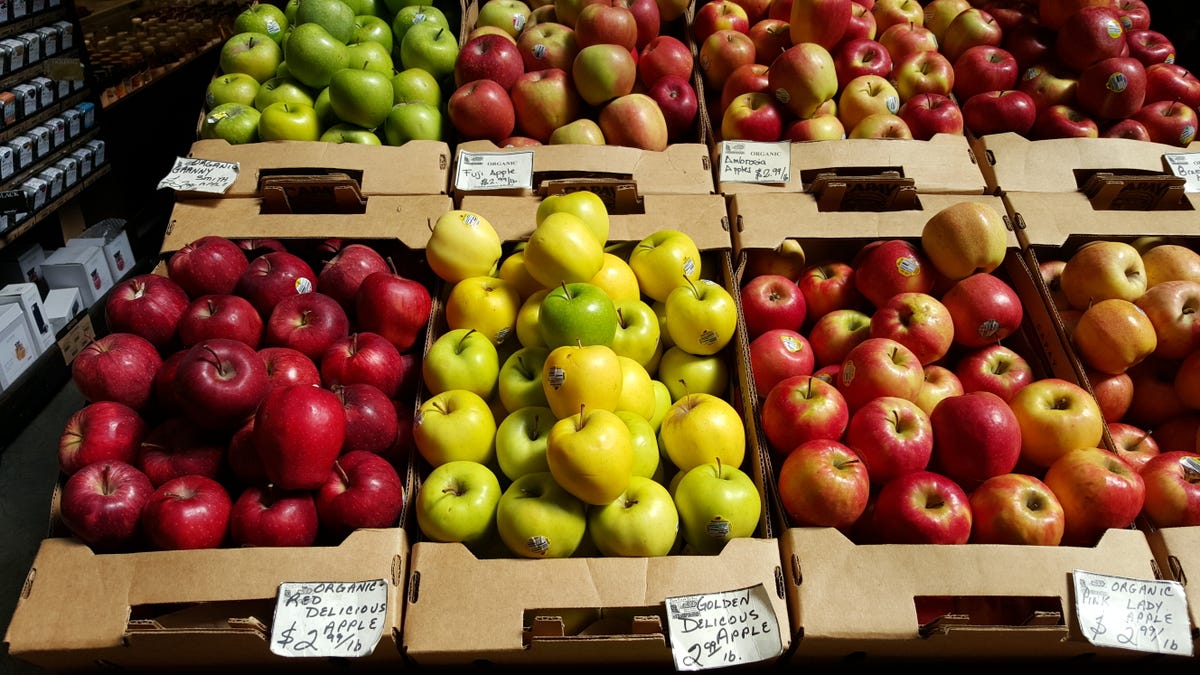
 Enlarge Image
Enlarge ImageLynn La/CNET

 Enlarge Image
Enlarge ImageLynn La/CNET

 Enlarge Image
Enlarge ImageLynn La/CNET
5. Your friendly neighborhood Irish bar
This picture was taken in a very low-lit environment. While the Galaxy S6’s photo is objectively brighter, I prefer the iPhone’s image. Objects are still visible and faces are sharp, but it managed to handle the lighting from the hanging bulbs better, without the same haziness or lens flares you see in the other two. The worst of the three was the M9. Not only did the picture remain dim, but objects looked blurry and grainy compared to the others.

 Enlarge Image
Enlarge ImageLynn La/CNET
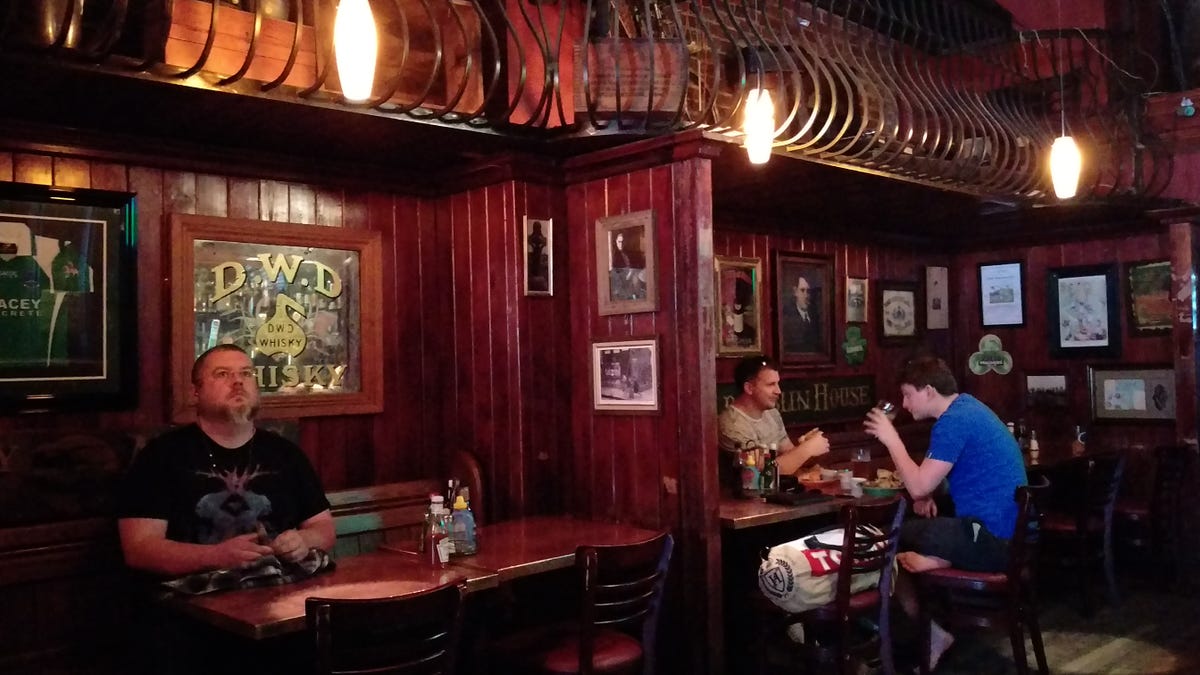
 Enlarge Image
Enlarge ImageLynn La/CNET

 Enlarge Image
Enlarge ImageLynn La/CNET
6. A dream kitchen
Here, the Galaxy S6 and the iPhone 6 are quite equal. Objects are sharp, lighting is even, and colors are accurately captured. At full resolution, however, you can begin to discern a few differences. Notably, the white flowers in the mid-ground are just a hair sharper on the Galaxy S6. Unfortunately, the M9 once again performed the weakest. The lighting on the top right is overexposed and when you zoom in, the flower petals are blotchy.

 Enlarge Image
Enlarge ImageLynn La/CNET

 Enlarge Image
Enlarge ImageLynn La/CNET

 Enlarge Image
Enlarge ImageLynn La/CNET
7. Sunny days in San Francisco
With HDR shooting mode on, I snapped a relatively non-challenging image of a partial San Francisco skyline. Though all three handsets performed well, the M9 had an odd light flare at the bottom right-hand corner. And while I liked the way the sky appeared on the iPhone more (the blue is deeper), the Galaxy S6 had the most even-toned colors overall. The iPhone and the M9, in comparison, was more bluish, with the latter being the most blue.

 Enlarge Image
Enlarge ImageLynn La/CNET
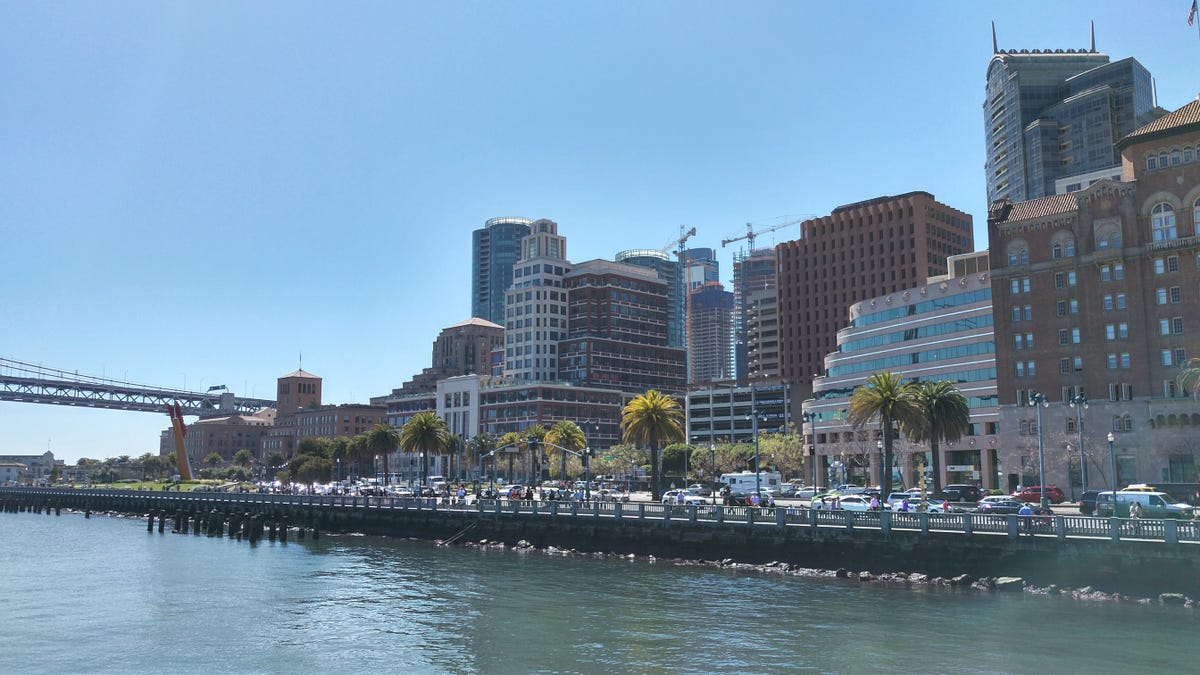
 Enlarge Image
Enlarge ImageLynn La/CNET

 Enlarge Image
Enlarge ImageLynn La/CNET
8. Tricky lighting at the Slanted Door
To see how well the smartphones could handle two different exposures with HDR activated, I took a challenging photo inside a busy restaurant that included bright windows. The Galaxy S6’s performance was disappointing. Though it was able to capture the outside environment the best (as you can see with the buildings through the window), the area indoors was too dark. Even after I tried to touch-focus some of the objects from the restaurant, the photo remained underexposed. Both the M9 and the iPhone managed to light the restaurant well, though neither of them could capture objects outside the window well enough. All in all, I’d say the winner of this round was the iPhone, since it was able to retain the details inside the restaurant, while capturing at least some details outdoors.

 Enlarge Image
Enlarge ImageLynn La/CNET

 Enlarge Image
Enlarge ImageLynn La/CNET

 Enlarge Image
Enlarge ImageLynn La/CNET
9. Night time in the City
In another low-light environment, this time outdoors at night, the iPhone took the better photo. Again, all handsets were set in Auto mode, and you can see how Apple’s handset didn’t capture the lens flares emanating from the stop lights like the other two. The cars and buildings are much more in focus as well, and the iPhone managed to capture some stars in the night sky too.
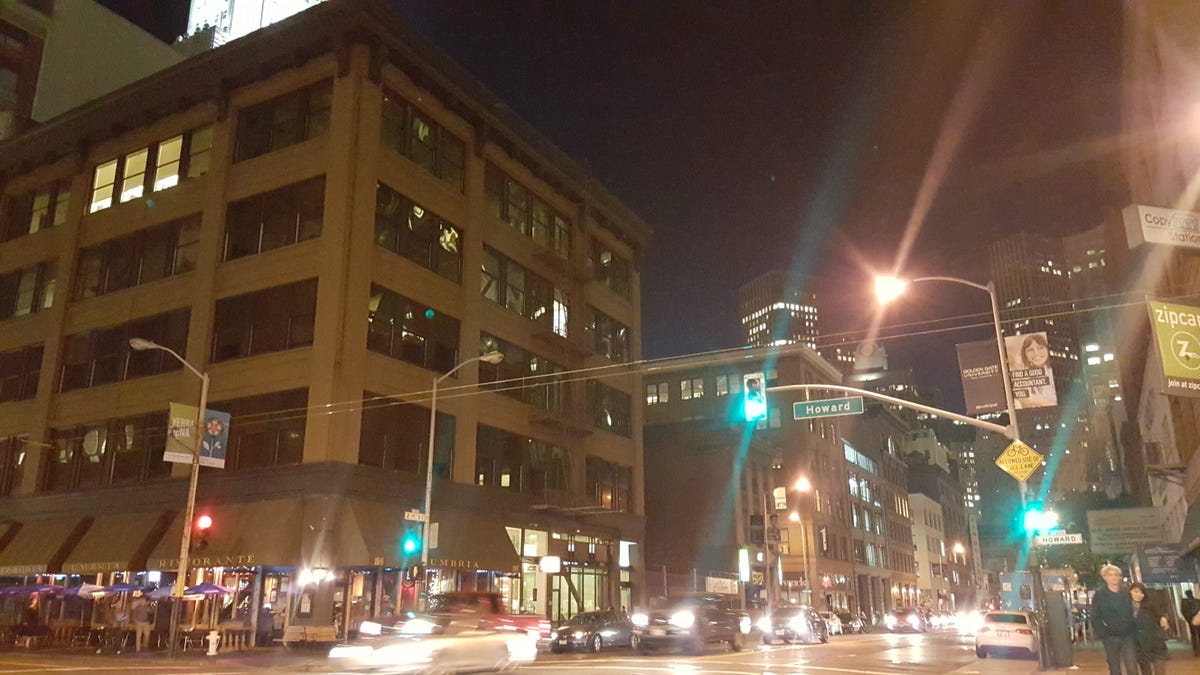
 Enlarge Image
Enlarge ImageLynn La/CNET

 Enlarge Image
Enlarge ImageLynn La/CNET

 Enlarge Image
Enlarge ImageLynn La/CNET
10. Sitting pretty indoors with fluorescent lights
This indoor image was taken with fluorescent lighting from above. All devices took the picture adequately, but I especially like how deep the purple hues came out with the Galaxy S6. However, you can see it lost some details with the darker black colors, like in Sarah’s (middle) black pants and Nick’s (right) black shirt. The M9 looks the most washed out, but only barely, compared to all three. Lastly, I liked how the skin tones on the iPhone appeared the most. Particularly noticeable at full resolution, the faces on the iPhone were the most evenly lit and accurately toned.

 Enlarge Image
Enlarge ImageLynn La/CNET

 Enlarge Image
Enlarge ImageLynn La/CNET

 Enlarge Image
Enlarge ImageLynn La/CNET
11. Sitting pretty outdoors with natural sunlight
Again, all phones took this photo well enough, but the Galaxy S6 had a slight edge on this round. It managed to portray a lot more depth and shadowing with the bamboo leaves in the background, while on the M9 and the iPhone they look a tad more washed out. All three faces also look more textured on the Samsung handset, and at full resolution, you can see sharper details on Sharon’s (left) purple dress.

 Enlarge Image
Enlarge ImageLynn La/CNET

 Enlarge Image
Enlarge ImageLynn La/CNET

 Enlarge Image
Enlarge ImageLynn La/CNET
12. Photos over not-so-troubled water
When it comes to these fast-moving fountain water shots, I prefer the iPhone’s image. The picture is brighter than the other two, without appearing overexposed, and the blueness of the water looks more natural. In addition, the water droplets are crisper and sharper than the Galaxy S6 and the M9.

 Enlarge Image
Enlarge ImageLynn La/CNET

 Enlarge Image
Enlarge ImageLynn La/CNET

 Enlarge Image
Enlarge ImageLynn La/CNET
13. Still Life 101
In our standard studio shot, all three devices’ photos had sharp objects that were nicely in focus. However, the Galaxy S6 had a yellow-tinged white background, particularly in the center, and its black-to-grey color gradient on the right wasn’t as distinguished as the M9 and the iPhone. In addition, the iPhone had the truest and purest white hues.

 Enlarge Image
Enlarge ImageLynn La/CNET

 Enlarge Image
Enlarge ImageLynn La/CNET

 Enlarge Image
Enlarge ImageLynn La/CNET



